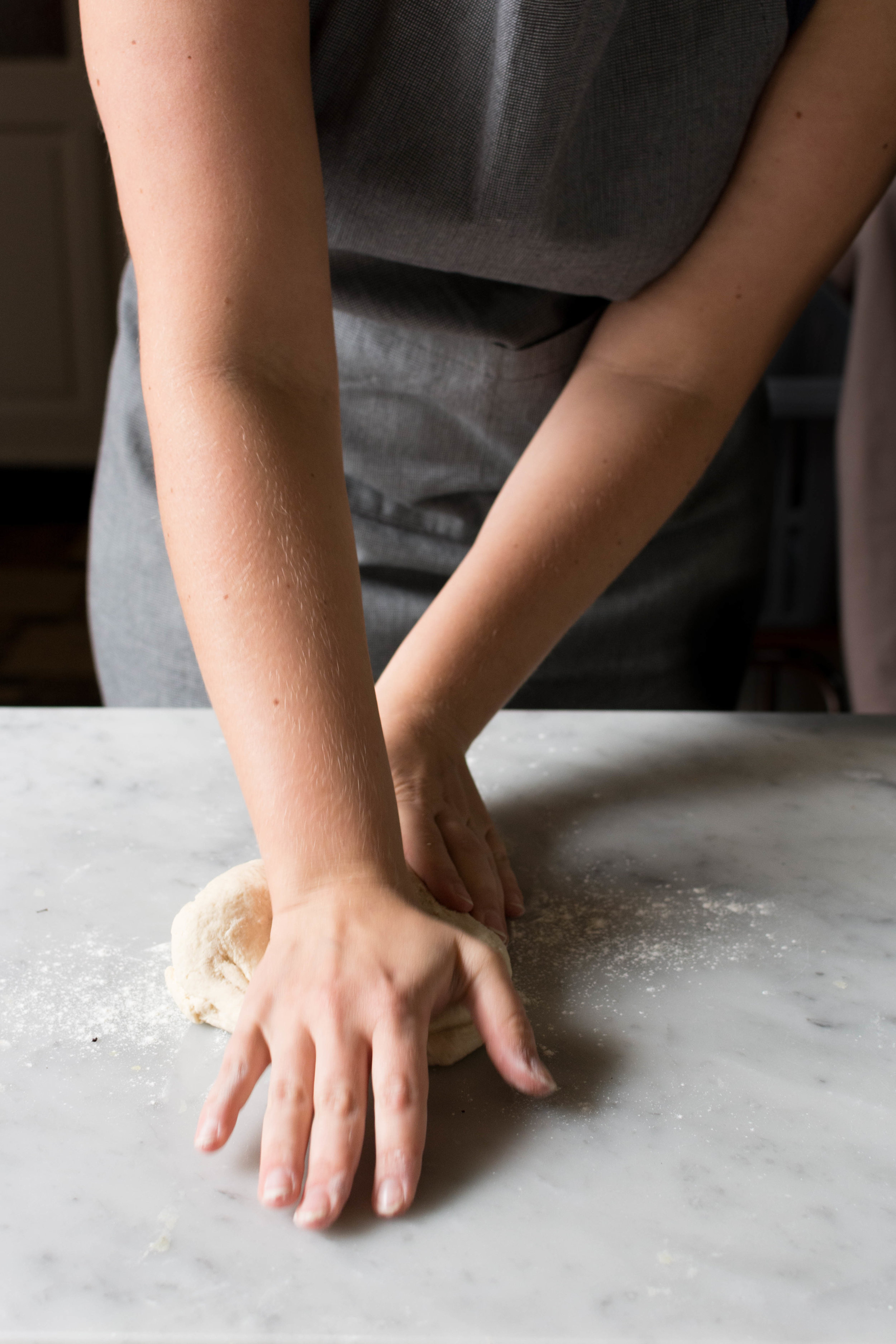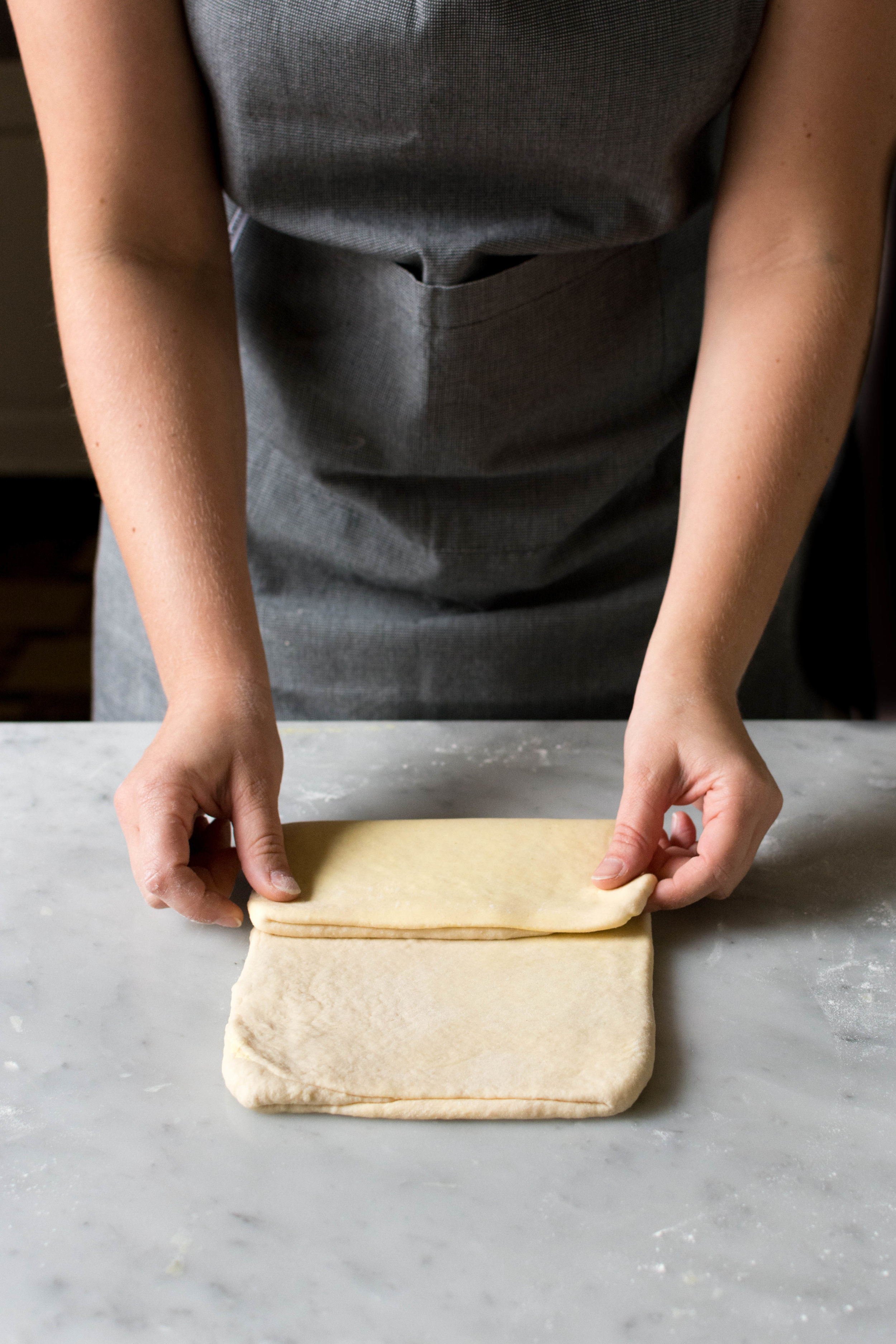My alarm goes off. Thomas grumbles. It is 6 am on a Sunday morning.
I get out of bed, find slippers and pajama pants, and head downstairs. I turn on the light, then the heating, the oven and the kettle. As I wait for the water to boil, I rinse my french press, discard the remains of the day before, and measure 40 grams of coarsely ground coffee. The kettle stops and I pour hot water over the coffee grounds. I set the timer for 4 minutes and read through my notes one more time. I stir the brewing coffee once with a wooden paddle, then wait until the timer tells me it's ready.
After I've poured my first cup of coffee, I take a container of sweetened condensed milk and transfer its contents to a bowl. I cover the bowl with aluminum foil, place it in a baking tray, and fill that with the rest of the water in the kettle, before placing it all in the oven. I set another timer, take a few sips of coffee and check my phone. 6.30. I gather ingredients for my dough, put on an apron, and get to work.
I knead. I shape. I wait. Another cup of coffee.
I BANG BANG BANG the cold butter with a rolling pin. Place it on top of the dough and fold it in.
I roll and turn and roll. Again and again. Dust off excess flour. Fold. Roll again. Flip, roll, turn, roll, fold. One more time.
The timer beeps. I check the dulce de leche, stir and see a beautiful caramel brown swirl appear. I stir until the color is uniform, sprinkle fleur de sel on top, and stir again. I resist the urge to taste the scalding hot caramel, put it aside, and return to my dough.
Roll. Turn. Roll. Flip. Roll. Repeat. Until I have a clean, smooth rectangle. Then the measuring and the cutting. A billion 2 cm strips, still nicely attached to the center. This will be pretty.
Next are the apples. Peeled, cored, diced. A little sprinkle of lemon juice, a good pinch of cinnamon and combined. A few minutes to macerate, then drained. Don't forget to drain.
Now, here we go. One, a good slather of dulce de leche. Two, a heaping pile of apples. Three, the braiding. From left to right, right to left, one over the other. Back and forth, until it's done and beautiful and we - the dough and I - rest.
Sometimes, a long series of precise and deliberate actions is just what you need to clear your mind.
notes
• The Danish dough is made with fresh yeast and I will always prefer it that way, but I know not everyone can get their hands on it. If you want to use instant or dry active yeast instead, consult an online converter to know how much you need - I usually use this one. If you want to read up on the differences between fresh, instant and dry active yeast, The Kitchn has a couple of articles on the matter. You can find them here and here.
• There are several ways to make your own dulce de leche (Food52 even has a recipe that starts from plain rather than condensed milk!), so feel free to use whatever method suits you best. I've provided the instructions for Naomi Robinson's oven method below, because that's the one I prefer. If you don't want to go through the trouble of making your own dulce de leche - which is really very little trouble at all - it should be available at several high-end supermarkets.
• If you make your own dulce de leche, you will have quite a lot left over. Store leftovers in a sealed jar in the fridge for up to 3 weeks. Use it as a spread on toast or a syrup over ice cream, cake or pie.
apple dulce de leche danish
danish dough adapted from syntra west, dulce de leche from bakers royale
makes one large danish (serves 4 to 6)
for the dulce de leche
1 can of sweetened condensed milk
1 tbsp fleur de sel
for the danish dough
125 ml water, cold
12,5 g fresh yeast
1 large egg yolk, cold and whisked
250 g all-purpose flour
25 g granulated sugar
4 g salt
88 g unsalted butter, cold
for the filling
2 large apples (ca. 350 g)
juice of 1/2 lemon
1/4 tsp cinnamon
how to
for the dulce de leche
1. Preheat oven to 210˚C.
2. Empty the contents of 1 can of sweetened condensed milk into an oven-proof dish and cover tightly with aluminum foil. To create the water bath, place the covered dish into a larger baking tray and fill the latter with hot water until it reaches to about 3/4 up the covered dish.
3. Bake for 60-90 minutes, adjusting the water level when needed, until the milk takes on a light brown appearance. Don't worry if it doesn't have a deep caramel color - as you stir the dulce de leche, the color will deepen. Remove from the oven and whisk until smooth. Let cool.
for the danish dough
1. In the bowl of an electric stand mixer fitted with the dough hook, stir water, yeast and roughly half of the egg yolk together with your hands. (Keep the rest of the egg yolk for the egg wash.) Add 1/3 of the flour and knead until it starts to look crumbly. Add the rest of the flour along with the sugar and salt and knead until the dough is fully combined and smooth.
2. Dump dough out onto a lightly floured work surface, form into a ball and then pat into a rough rectangle. Try not to work the dough too much. The rectangle can still be fairly thick (1 - 2 cm).
3. Place the butter between 2 pieces of parchment paper and bang or roll with a rolling pin until it is about half the size of the dough. The objective here is to make the butter a little more elastic, without actually melting it. Place the butter on top of one half of the dough and fold over the other half, sealing the edges by pinching the dough together.
4. Roll the dough into a long rectangle, now about 1 cm thick. Lightly flour the work surface as needed. When the dough is large enough, dust off excess flour and place it with the short edge facing towards you. Fold the dough like a business letter, first folding the top third over the center, then the bottom third over that. This is your first turn.
5. Turn the dough 90˚, so that the short edge is facing you and roll into a rectangle of roughly the same size. Repeat the folding process to finish a second turn, then repeat the entire process. You have now given the dough 3 turns. Wrap the dough in plastic wrap and allow to rest in the refrigerator for 10 to 20 minutes.
to assemble
1. Peel and core the apples, then cut them into small pieces (ca. 1 cm). Place in a medium bowl and combine with the lemon juice and cinnamon. Allow to macerate while you cut the dough.
2. On a lightly floured work surface, roll dough into a rectangle of ca. 27 x 30 cm (11 x 12 inches) and place it with the shortest edge facing toward you. Using the back of the knife, mark a vertical line at 1/3 and 2/3 of the width of the dough, making sure not to cut all the way through. In both the left and the right part of the dough, make horizontal cuts, starting at the vertical guideline and working outwards, thus leaving the center of the dough intact and the strips attached to it. Leave about 2 cm (a scant inch) between each horizontal cut. Cut away the top and bottom strips to create a little flap on either side of the dough. This will help seal in the filling.
3. Spread a thick layer of dulce de leche onto the center of the dough. Drain the apples to remove excess liquid and pile the fruit onto the dulce de leche. Fold the top flap over the filling and start braiding your way down. At a slightly downward angle, fold the top right strip over the flap. At the same angle, fold the top left strip over the right. Work your way down until you reach the end of the pastry. Tuck the bottom flap underneath the bottom strips and pinch the edges to seal.
4. Transfer the danish onto a baking sheet lined with parchment paper, cover with a clean towel and allow to rise at room temperature until the dough looks puffed (it took about 1 hour for me).
5. Preheat oven to 210˚C, with a baking sheet placed on the middle rack. Mix the remainder of the egg yolk (from the dough) with a pinch of salt and a splash of water for the egg wash.
6. Lightly brush the top of the danish with the egg wash. Sprinkle a little cinnamon sugar on top (optional). Slide baking sheet onto the preheated baking sheet and bake for 25 - 35 minutes, until puffed and golden. If you're not sure if it's fully baked, check the bottom of the pastry. This, too, should be crisp and golden.





